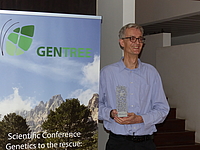

Reading tree rings allows you to fly back in time and see how a tree interacted with its environment over past centuries. GenTree — a Europe-wide project — has now analysed rings from more than 3600 trees across Europe. The newly published dataset covers seven ecologically and economically important tree species from 142 forest sites, and the data from this vast dendrochronological study will help managers and scientists to assess how forests may adapt to future climate scenarios.
The beauty of dendrochronology, according to Patrick Fonti, team leader in the tree-ring research group at the Swiss Federal Institute for Forest, Snow and Landscape Research (WSL), is that it can provide information for so many disciplines.
“Everything that trees can perceive and register can be the subject of your dendrochronological research. For anything that changes over time in the environment, tree rings can give you insights.” These events might be forest fires or floods or weather conditions.
Among others, tree rings have been widely used in climatological studies to reconstruct past temperatures, and in archaeological studies to identify the origin of wood from ancient buildings. For example, the rooftop structure of a church in the Andalusian city of Seville in Spain, built on the site of a medieval mosque, reused timbers from previous constructions. These recycled timbers provided evidence of historical rafting of timbers down the Guadalquivir river, demonstrating the complexity of the timber supply at the turn of the 18th century.
The most important archive of tree-ring data worldwide is the International Tree-Ring Data Bank (ITRDB). It has more than 4250 datasets of 226 tree species from all continents where trees grow. However, most of the ITRDB data were collected to answer specific research questions, often related to climate reconstructions. As a result, they were obtained by sampling old and climatically stressed trees, to maximize the climatic signal.
The GenTree dataset overcomes this limitation, according to Elisabet Martínez-Sancho, a postdoc researcher in the tree-ring research group at WSL and first author of the paper that describes the dataset.
“The tree-ring datasets available in the ITRDB represent only a part of European forests,” Martínez-Sancho says, “so it is necessary to combine them with data from non-stressed populations to represent all the environmental conditions where tree species are growing and better assess their potential to adjust to climate change”.
The potential of this GenTree dataset, which is freely available on Figshare and described in Scientific Data journal, goes far beyond the project goals of GenTree. Most importantly, perhaps, it will allow researchers to assess forest properties under climate change scenarios without the bias inherent in the ITRDB.

